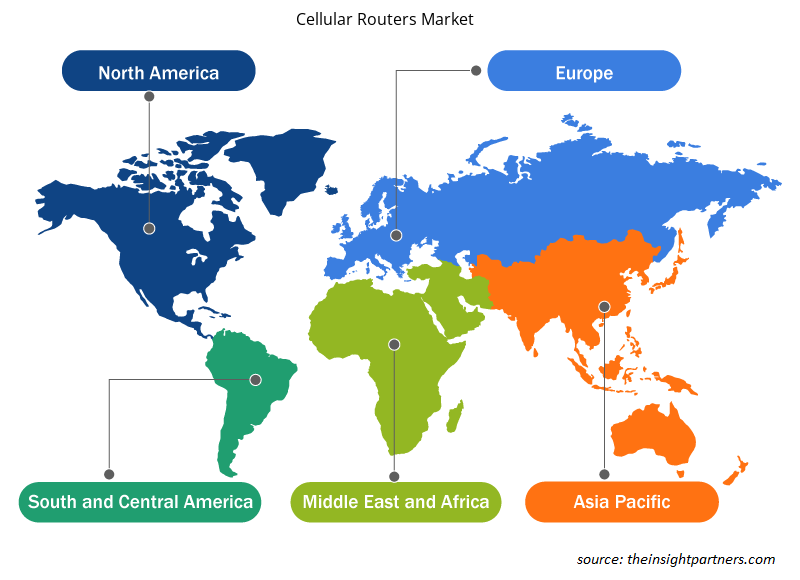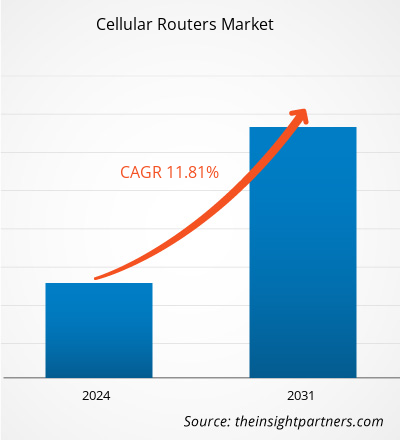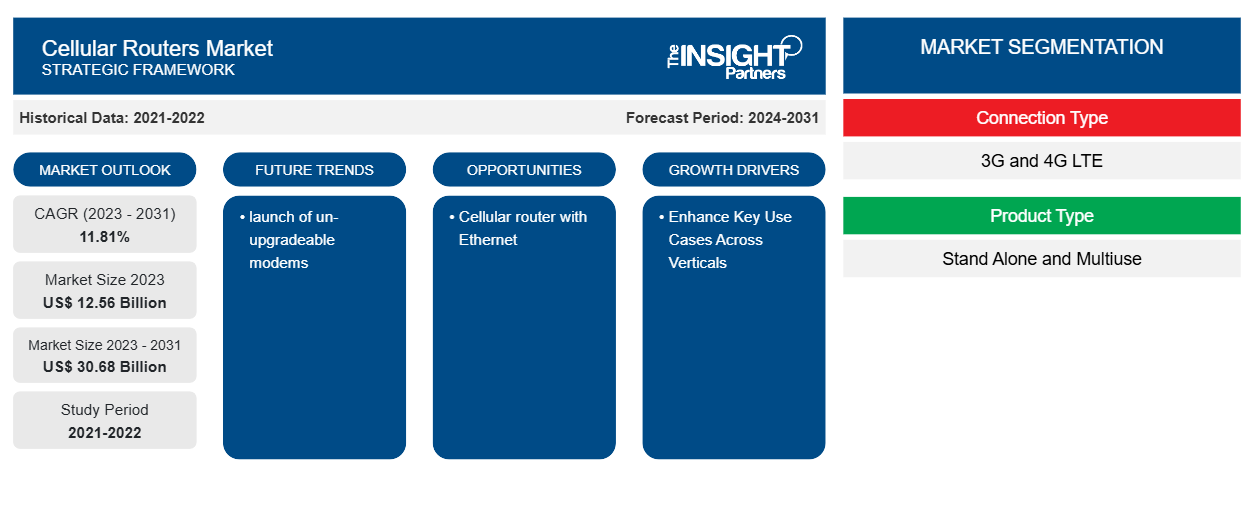Le marché des routeurs cellulaires devrait atteindre 30,68 milliards de dollars d'ici 2031, contre 12,56 milliards de dollars en 2023. Le marché devrait enregistrer un TCAC de 11,81 % en 2023-2031. Le lancement de modems non évolutifs devrait rester une tendance clé du marché.
Analyse du marché des routeurs cellulaires
- Plusieurs aspects importants contribuent à l'expansion rapide du marché. Le déploiement mondial des modems cellulaires 5G est motivé par le besoin croissant de communications à haut débit et à faible latence en raison de la croissance de la technologie SG dans le monde entier.
- La connectivité cellulaire est de plus en plus intégrée dans divers instruments, tels que les appareils IOT, les gadgets pour maison intelligente et les équipements industriels, stimulant ainsi la croissance du marché.
Aperçu du marché des routeurs cellulaires
- Les routeurs cellulaires utilisent la technologie cellulaire pour fournir une connectivité Internet. Ils constituent une excellente option pour les entreprises, les ménages et d'autres endroits qui n'ont pas accès à des services Internet filaires comme le câble ou la fibre optique.
- Cela fait des routeurs cellulaires un outil utile pour les organisations et les particuliers opérant dans des endroits éloignés ou qui ont besoin de rester connectés lorsqu'ils voyagent.
- Ils présentent plusieurs qualités majeures qui en font un excellent choix pour l'informatique et la communication mobiles : connectivité à vitesse Gigabit ; les routeurs cellulaires offrent des connexions rapides et fiables à des débits allant jusqu'à 5G et 4G LTE, permettant un accès rapide aux services de streaming et aux applications Web.
- Portabilité : les routeurs cellulaires sont des appareils légers et petits, simples à transporter et à configurer.
Personnalisez ce rapport en fonction de vos besoins
Vous bénéficierez d'une personnalisation gratuite de n'importe quel rapport, y compris de certaines parties de ce rapport, d'une analyse au niveau des pays, d'un pack de données Excel, ainsi que de superbes offres et réductions pour les start-ups et les universités.
-
Obtenez les principales tendances clés du marché de ce rapport.Cet échantillon GRATUIT comprendra une analyse de données, allant des tendances du marché aux estimations et prévisions.
Facteurs moteurs et opportunités du marché des routeurs cellulaires
Améliorer les cas d'utilisation clés dans tous les secteurs verticaux pour favoriser le marché
- Alors que les réseaux Wi-Fi sont la norme dans de nombreuses entreprises, les routeurs cellulaires gagnent en popularité dans de nombreux secteurs en raison de leur capacité à donner accès aux données sans fil sur les réseaux cellulaires.
- Les routeurs Wi-Fi établissent une connexion réseau sans fil entre deux appareils, généralement via des ondes radio, pour fournir un accès Wi-Fi haut débit sur de courtes distances. Le Wi-Fi est généralement utilisé pour accéder à Internet via un routeur sans fil relié à une connexion filaire haut débit.
- Les routeurs cellulaires utilisent des tours cellulaires pour fournir une connectivité Internet sans fil sur de longues distances. Ils sont souvent utilisés pour se connecter à Internet via un téléphone portable ou un autre appareil mobile, mais ils peuvent également prendre en charge des réseaux étendus dans les zones rurales. Cela les rend particulièrement adaptés à plusieurs cas d'utilisation majeurs dans différents secteurs : vente au détail, soins de santé, transport, fabrication et autres.
Routeur cellulaire avec Ethernet
- De nombreux routeurs transmettent Internet sans fil à tous les appareils de leurs réseaux Wi-Fi. Dans d'autres cas, vous devrez peut-être connecter votre appareil au routeur à l'aide d'un câble Ethernet. Un câble Ethernet est un câble personnalisé qui fournit une connexion Internet câblée. Avant le Wi-Fi, toutes les connexions Internet nécessitaient un câble Ethernet branché dans un mur.wirelessly to all devices on their wifi networks. Other times, you may need to connect your device to the router using an Ethernet wire. An Ethernet cable is a customized cable that Provides a hardwired internet connection. Before wifi, all internet connections required an Ethernet wire hooked into a wall.
- Les connexions Ethernet offrent généralement une connexion Internet plus rapide et plus stable que le Wi-Fi. Cependant, elles sont peu pratiques lorsque l'utilisateur doit déplacer physiquement l'appareil. La plupart des téléphones et autres appareils mobiles ne disposent pas de connexions par câble Ethernet, vous devrez donc acheter un adaptateur pour les connecter.wifi. However, they are inconvenient when the user needs to physically move the gadget. Most phones and other mobile devices lack Ethernet cable connections, so you'll need to purchase an adaptor to connect them.
Analyse de segmentation du rapport sur le marché des routeurs cellulaires
Les segments clés qui ont contribué à l’élaboration de l’analyse du marché des routeurs cellulaires sont le type de connexion, le type d’entreprise et l’utilisateur final.
- Par type de connexion, le marché est segmenté en 3G et 4G LTE.LTE.
- Par type de produit, le marché est segmenté en produits autonomes et multi-usages.
- En termes d'application, le marché est segmenté en commerce de détail et commercial, résidentiel, industriel et transport.
Analyse des parts de marché des routeurs cellulaires par géographie
- Le rapport sur le marché des routeurs cellulaires comprend une analyse détaillée de cinq grandes régions géographiques, qui comprend la taille actuelle et historique du marché et les prévisions pour 2021 à 2031, couvrant l'Amérique du Nord, l'Europe, l'Asie-Pacifique (APAC), le Moyen-Orient et l'Afrique (MEA) et l'Amérique du Sud et centrale.APAC), Middle East and Africa (MEA), and South & Central America.
- Chaque région est ensuite subdivisée en pays respectifs. Ce rapport fournit des analyses et des prévisions pour plus de 18 pays, couvrant la dynamique du marché des routeurs cellulaires, comme les facteurs moteurs, les tendances et les opportunités qui ont un impact sur les marchés au niveau régional.
- Le rapport couvre également l’analyse PEST, qui implique l’étude des principaux facteurs qui influencent le marché des routeurs cellulaires dans ces régions.
Aperçu régional du marché des routeurs cellulaires
Les tendances régionales et les facteurs influençant le marché des routeurs cellulaires tout au long de la période de prévision ont été expliqués en détail par les analystes d’Insight Partners. Cette section traite également des segments et de la géographie du marché des routeurs cellulaires en Amérique du Nord, en Europe, en Asie-Pacifique, au Moyen-Orient et en Afrique, ainsi qu’en Amérique du Sud et en Amérique centrale.

- Obtenez les données régionales spécifiques au marché des routeurs cellulaires
Portée du rapport sur le marché des routeurs cellulaires
| Attribut de rapport | Détails |
|---|---|
| Taille du marché en 2023 | 12,56 milliards de dollars américains |
| Taille du marché d'ici 2031 | 30,68 milliards de dollars américains |
| Taux de croissance annuel composé mondial (2023-2031) | 11,81% |
| Données historiques | 2021-2022 |
| Période de prévision | 2024-2031 |
| Segments couverts |
Par type de connexion
|
| Régions et pays couverts |
Amérique du Nord
|
| Leaders du marché et profils d'entreprises clés |
|
Densité des acteurs du marché des routeurs cellulaires : comprendre son impact sur la dynamique commerciale
Le marché des routeurs cellulaires connaît une croissance rapide, tirée par la demande croissante des utilisateurs finaux en raison de facteurs tels que l'évolution des préférences des consommateurs, les avancées technologiques et une plus grande sensibilisation aux avantages du produit. À mesure que la demande augmente, les entreprises élargissent leurs offres, innovent pour répondre aux besoins des consommateurs et capitalisent sur les tendances émergentes, ce qui alimente davantage la croissance du marché.
La densité des acteurs du marché fait référence à la répartition des entreprises ou des sociétés opérant sur un marché ou un secteur particulier. Elle indique le nombre de concurrents (acteurs du marché) présents sur un marché donné par rapport à sa taille ou à sa valeur marchande totale.
Les principales entreprises opérant sur le marché des routeurs cellulaires sont :
- Cradlepoint, Inc.
- Sierra Wireless, Inc.
- Digi International, Inc.
- Advantech Co. Ltd
- Moxa Inc
- Belden, Inc
Avis de non-responsabilité : les sociétés répertoriées ci-dessus ne sont pas classées dans un ordre particulier.

- Obtenez un aperçu des principaux acteurs du marché des routeurs cellulaires
Actualités et développements récents du marché des routeurs cellulaires
Le marché des routeurs cellulaires est évalué en collectant des données qualitatives et quantitatives après des recherches primaires et secondaires, qui comprennent des publications d'entreprise importantes, des données d'association et des bases de données. Quelques-uns des développements sur le marché des routeurs cellulaires sont répertoriés ci-dessous :
- D-Link, pionnier mondial des technologies de réseau et de connexion, a présenté le routeur intelligent R15 EAGLE PRO AI AX1500. Le tout nouveau routeur R15 EAGLE PRO AI combine la technologie wifi 6 la plus récente avec l'intelligence artificielle pour offrir une couverture et une vitesse wifi exceptionnelles. (Source : D-Link, Communiqués de presse, décembre 2021)
- Proscend a lancé un routeur cellulaire extérieur pour combler la fracture numérique. Le routeur cellulaire 4G LTE extérieur Proscend M366 est conçu pour des solutions d'accès sans fil fixe (FWA) rentables, faciles à déployer et flexibles. Grâce à la couverture réseau 4G mature, Proscend M366 ne profite pas seulement aux ménages vivant dans des zones non desservies et mal desservies où l'infrastructure filaire n'est pas accessible. (Source : Proscend, Communiqués de presse, avril 2022)
Rapport sur le marché des routeurs cellulaires : couverture et livrables
Le rapport « Taille et prévisions du marché des routeurs cellulaires (2021-2031) » fournit une analyse détaillée du marché couvrant les domaines ci-dessous :
- Taille et prévisions du marché des routeurs cellulaires aux niveaux mondial, régional et national pour tous les segments de marché clés couverts par le champ d'application
- Tendances du marché des routeurs cellulaires, ainsi que la dynamique du marché, comme les facteurs moteurs, les contraintes et les opportunités clés
- Analyse détaillée des cinq forces de PEST/Porter et SWOT
- Analyse du marché des routeurs cellulaires couvrant les principales tendances du marché, le cadre mondial et régional, les principaux acteurs, les réglementations et les développements récents du marché
- Analyse du paysage industriel et de la concurrence couvrant la concentration du marché, l'analyse de la carte thermique, les principaux acteurs et les développements récents sur le marché des routeurs cellulaires
- Profils d'entreprise détaillés
- Analyse historique (2 ans), année de base, prévision (7 ans) avec TCAC
- Analyse PEST et SWOT
- Taille du marché Valeur / Volume - Mondial, Régional, Pays
- Industrie et paysage concurrentiel
- Ensemble de données Excel
Rapports récents
Rapports connexes
Témoignages
Raison d'acheter
- Prise de décision éclairée
- Compréhension de la dynamique du marché
- Analyse concurrentielle
- Connaissances clients
- Prévisions de marché
- Atténuation des risques
- Planification stratégique
- Justification des investissements
- Identification des marchés émergents
- Amélioration des stratégies marketing
- Amélioration de l'efficacité opérationnelle
- Alignement sur les tendances réglementaires























 Obtenez un échantillon gratuit pour - Marché des routeurs cellulaires
Obtenez un échantillon gratuit pour - Marché des routeurs cellulaires